—lana Del Rey, Young And Beautiful

—lana del rey, young and beautiful
More Posts from Delightfulskywalker and Others
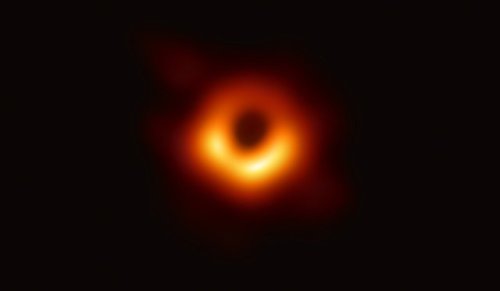
Astronomers Capture First Image of a Black Hole
The Event Horizon Telescope (EHT) — a planet-scale array of eight ground-based radio telescopes forged through international collaboration — was designed to capture images of a black hole. Today, in coordinated press conferences across the globe, EHT researchers revealed that they have succeeded, unveiling the first direct visual evidence of a supermassive black hole and its shadow. The image reveals the black hole at the centre of Messier 87, a massive galaxy in the nearby Virgo galaxy cluster. This black hole resides 55 million light-years from Earth and has a mass 6.5 billion times that of the Sun. Supermassive black holes are relatively tiny astronomical objects — which has made them impossible to directly observe until now. As the size of a black hole’s event horizon is proportional to its mass, the more massive a black hole, the larger the shadow. Thanks to its enormous mass and relative proximity, M87’s black hole was predicted to be one of the largest viewable from Earth — making it a perfect target for the EHT. The shadow of a black hole is the closest we can come to an image of the black hole itself, a completely dark object from which light cannot escape. The black hole’s boundary — the event horizon from which the EHT takes its name — is around 2.5 times smaller than the shadow it casts and measures just under 40 billion km across.
Credit: ESO



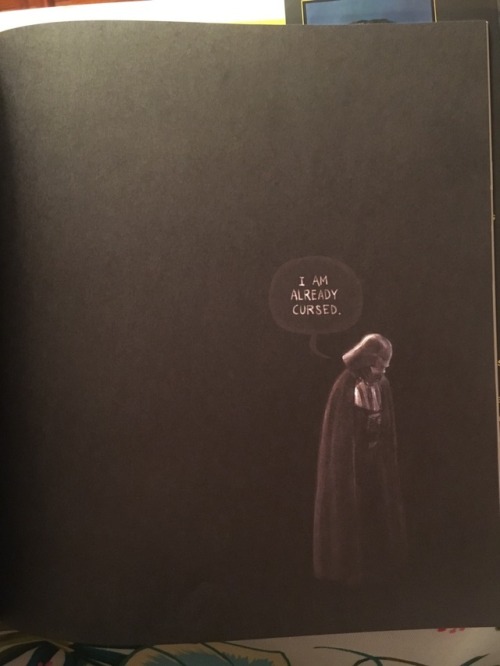


This is by far the best piece of Star Wars literature ever made
When Dead Stars Collide!
Gravity has been making waves - literally. Earlier this month, the Nobel Prize in Physics was awarded for the first direct detection of gravitational waves two years ago. But astronomers just announced another huge advance in the field of gravitational waves - for the first time, we’ve observed light and gravitational waves from the same source.

There was a pair of orbiting neutron stars in a galaxy (called NGC 4993). Neutron stars are the crushed leftover cores of massive stars (stars more than 8 times the mass of our sun) that long ago exploded as supernovas. There are many such pairs of binaries in this galaxy, and in all the galaxies we can see, but something special was about to happen to this particular pair.

Each time these neutron stars orbited, they would lose a teeny bit of gravitational energy to gravitational waves. Gravitational waves are disturbances in space-time - the very fabric of the universe - that travel at the speed of light. The waves are emitted by any mass that is changing speed or direction, like this pair of orbiting neutron stars. However, the gravitational waves are very faint unless the neutron stars are very close and orbiting around each other very fast.

As luck would have it, the teeny energy loss caused the two neutron stars to get a teeny bit closer to each other and orbit a teeny bit faster. After hundreds of millions of years, all those teeny bits added up, and the neutron stars were *very* close. So close that … BOOM! … they collided. And we witnessed it on Earth on August 17, 2017.

Credit: National Science Foundation/LIGO/Sonoma State University/A. Simonnet
A couple of very cool things happened in that collision - and we expect they happen in all such neutron star collisions. Just before the neutron stars collided, the gravitational waves were strong enough and at just the right frequency that the National Science Foundation (NSF)’s Laser Interferometer Gravitational-Wave Observatory (LIGO) and European Gravitational Observatory’s Virgo could detect them. Just after the collision, those waves quickly faded out because there are no longer two things orbiting around each other!
LIGO is a ground-based detector waiting for gravitational waves to pass through its facilities on Earth. When it is active, it can detect them from almost anywhere in space.

The other thing that happened was what we call a gamma-ray burst. When they get very close, the neutron stars break apart and create a spectacular, but short, explosion. For a couple of seconds, our Fermi Gamma-ray Telescope saw gamma-rays from that explosion. Fermi’s Gamma-ray Burst Monitor is one of our eyes on the sky, looking out for such bursts of gamma-rays that scientists want to catch as soon as they’re happening.
And those gamma-rays came just 1.7 seconds after the gravitational wave signal. The galaxy this occurred in is 130 million light-years away, so the light and gravitational waves were traveling for 130 million years before we detected them.

After that initial burst of gamma-rays, the debris from the explosion continued to glow, fading as it expanded outward. Our Swift, Hubble, Chandra and Spitzer telescopes, along with a number of ground-based observers, were poised to look at this afterglow from the explosion in ultraviolet, optical, X-ray and infrared light. Such coordination between satellites is something that we’ve been doing with our international partners for decades, so we catch events like this one as quickly as possible and in as many wavelengths as possible.

Astronomers have thought that neutron star mergers were the cause of one type of gamma-ray burst - a short gamma-ray burst, like the one they observed on August 17. It wasn’t until we could combine the data from our satellites with the information from LIGO/Virgo that we could confirm this directly.

This event begins a new chapter in astronomy. For centuries, light was the only way we could learn about our universe. Now, we’ve opened up a whole new window into the study of neutron stars and black holes. This means we can see things we could not detect before.

The first LIGO detection was of a pair of merging black holes. Mergers like that may be happening as often as once a month across the universe, but they do not produce much light because there’s little to nothing left around the black hole to emit light. In that case, gravitational waves were the only way to detect the merger.

Image Credit: LIGO/Caltech/MIT/Sonoma State (Aurore Simonnet)
The neutron star merger, though, has plenty of material to emit light. By combining different kinds of light with gravitational waves, we are learning how matter behaves in the most extreme environments. We are learning more about how the gravitational wave information fits with what we already know from light - and in the process we’re solving some long-standing mysteries!
Want to know more? Get more information HERE.
Make sure to follow us on Tumblr for your regular dose of space: http://nasa.tumblr.com

Ten interesting facts about Uranus
Like the classical planets, Uranus is visible to the naked eye, but it was never recognised as a planet by ancient observers because of its dimness and slow orbit. Sir William Herschel announced its discovery on 13 March 1781, expanding the known boundaries of the Solar System for the first time in history and making Uranus the first planet discovered with a telescope.

1° Uranus is the seventh planet from the Sun. It has the third-largest planetary radius and fourth-largest planetary mass in the Solar System. Uranus is similar in composition to Neptune, and both have different bulk chemical composition from that of the larger gas giants Jupiter and Saturn.

2° Like all of the giant planets, Uranus has its share of moons. At present, astronomers have confirmed the existence of 27 natural satellites. But for the most part, these moons are small and irregular.

3° Uranus’ moons are named after characters created by William Shakespeare and Alexander Pope. These include Oberon, Titania and Miranda. All are frozen worlds with dark surfaces. Some are ice and rock mixtures. The most interesting Uranian moon is Miranda; it has ice canyons, terraces, and other strange-looking surface areas.

4° Only one spacecraft in the history of spaceflight has ever made a close approach to Uranus. NASA’s Voyager 2 conducted its closest approach to Uranus on January 24th, 1986, passing within 81,000 km of the cloud tops of Uranus. It took thousands of photographs of the gas/ice giant and its moons before speeding off towards its next target: Neptune.

5° Uranus has rings: All the gas and ice giants have their own ring systems, and Uranus’ is the second most dramatic set of rings in the Solar System.
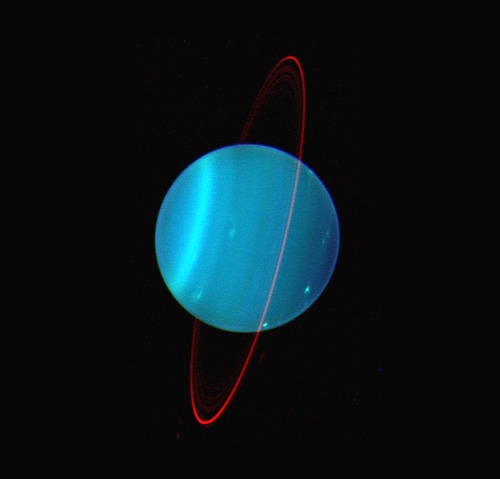
6° Uranus makes one trip around the Sun every 84 Earth years. During some parts of its orbit one or the other of its poles point directly at the Sun and get about 42 years of direct sunlight. The rest of the time they are in darkness.

7° All of the planets in the Solar System rotate on their axis, with a tilt that’s similar to the Sun. In many cases, planet’s have an axial tilt, where one of their poles will be inclined slightly towards the Sun. But the axial tilt of Uranus is a staggering 98 degrees! In other words, the planet is rotating on its side.

8° Uranus is approximately 4 times the sizes of Earth and 63 times its volume.

9° Uranus is blue-green in color, the result of methane in its mostly hydrogen-helium atmosphere. The planet is often dubbed an ice giant, since 80 percent or more of its mass is made up of a fluid mix of water, methane, and ammonia ices.

10° Uranus hits the coldest temperatures of any planet. With minimum atmospheric temperature of -224°C Uranus is nearly coldest planet in the solar system. While Neptune doesn’t get as cold as Uranus it is on average colder. The upper atmosphere of Uranus is covered by a methane haze which hides the storms that take place in the cloud decks.
source 1, source 2, source 2
Images credit: NASA



CHAPTER 15: THE BELIEVER

The Force
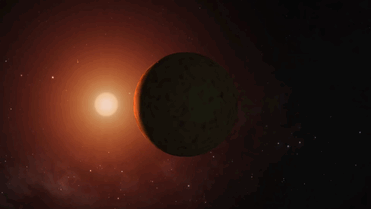
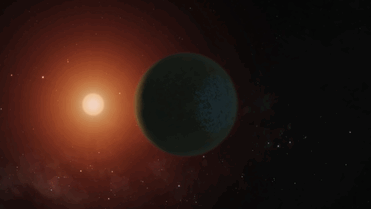
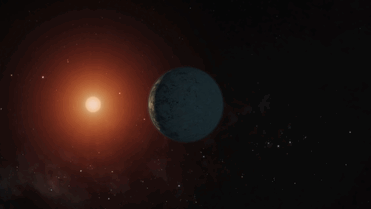
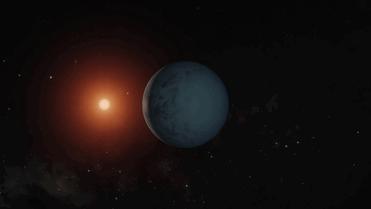


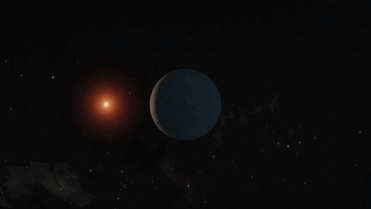
TRAPPIST-1 Planets - Flyaround Animation
Credit: NASA/Spitzer
-
 peacelovejoysami liked this · 3 weeks ago
peacelovejoysami liked this · 3 weeks ago -
 danasdreams liked this · 3 weeks ago
danasdreams liked this · 3 weeks ago -
 oceanbreezeandhoneybees reblogged this · 3 weeks ago
oceanbreezeandhoneybees reblogged this · 3 weeks ago -
 marxistfurry reblogged this · 1 month ago
marxistfurry reblogged this · 1 month ago -
 444belle reblogged this · 1 month ago
444belle reblogged this · 1 month ago -
 444belle liked this · 1 month ago
444belle liked this · 1 month ago -
 hartshell90 reblogged this · 1 month ago
hartshell90 reblogged this · 1 month ago -
 hartshell90 reblogged this · 1 month ago
hartshell90 reblogged this · 1 month ago -
 hartshell90 liked this · 1 month ago
hartshell90 liked this · 1 month ago -
 worldtravelergurl reblogged this · 1 month ago
worldtravelergurl reblogged this · 1 month ago -
 worldtravelergurl liked this · 1 month ago
worldtravelergurl liked this · 1 month ago -
 hiddenhmm liked this · 1 month ago
hiddenhmm liked this · 1 month ago -
 gildedlilacss reblogged this · 1 month ago
gildedlilacss reblogged this · 1 month ago -
 midnight-g0ddess reblogged this · 1 month ago
midnight-g0ddess reblogged this · 1 month ago -
 p0rcelainnymph reblogged this · 1 month ago
p0rcelainnymph reblogged this · 1 month ago -
 p0rcelainnymph liked this · 1 month ago
p0rcelainnymph liked this · 1 month ago -
 onlythegentle-survive reblogged this · 2 months ago
onlythegentle-survive reblogged this · 2 months ago -
 autistic-puffin liked this · 2 months ago
autistic-puffin liked this · 2 months ago -
 justanotherblonde23 reblogged this · 2 months ago
justanotherblonde23 reblogged this · 2 months ago -
 rogueriverfishingwar reblogged this · 2 months ago
rogueriverfishingwar reblogged this · 2 months ago -
 midnightglances liked this · 2 months ago
midnightglances liked this · 2 months ago -
 oceanbreezeandhoneybees reblogged this · 2 months ago
oceanbreezeandhoneybees reblogged this · 2 months ago -
 mearad reblogged this · 3 months ago
mearad reblogged this · 3 months ago -
 haloperidolic liked this · 4 months ago
haloperidolic liked this · 4 months ago -
 cloudyyyy6 liked this · 5 months ago
cloudyyyy6 liked this · 5 months ago -
 stacys-mom-has-got-it-goin-on reblogged this · 7 months ago
stacys-mom-has-got-it-goin-on reblogged this · 7 months ago -
 heavensdream liked this · 7 months ago
heavensdream liked this · 7 months ago -
 pixiemeat0 liked this · 7 months ago
pixiemeat0 liked this · 7 months ago -
 skullknightspiced liked this · 7 months ago
skullknightspiced liked this · 7 months ago -
 ironictalesofficial liked this · 7 months ago
ironictalesofficial liked this · 7 months ago -
 ithinkiforgottotakexanax reblogged this · 7 months ago
ithinkiforgottotakexanax reblogged this · 7 months ago -
 ithinkiforgottotakexanax liked this · 7 months ago
ithinkiforgottotakexanax liked this · 7 months ago -
 cigga-rette reblogged this · 7 months ago
cigga-rette reblogged this · 7 months ago -
 reluctanttorturedpoet liked this · 7 months ago
reluctanttorturedpoet liked this · 7 months ago -
 m6lancholiaa liked this · 7 months ago
m6lancholiaa liked this · 7 months ago -
 dollykiller liked this · 7 months ago
dollykiller liked this · 7 months ago -
 sweetgyarukiss liked this · 7 months ago
sweetgyarukiss liked this · 7 months ago -
 princessfaerygia reblogged this · 7 months ago
princessfaerygia reblogged this · 7 months ago -
 princessfaerygia liked this · 7 months ago
princessfaerygia liked this · 7 months ago -
 fawnangel555 reblogged this · 7 months ago
fawnangel555 reblogged this · 7 months ago -
 fawnangel555 liked this · 7 months ago
fawnangel555 liked this · 7 months ago -
 eekstravagantna liked this · 7 months ago
eekstravagantna liked this · 7 months ago
"Hope is like the sun. If you only believe it when you see it, you'll never make it through the night." -Princess Leia
286 posts
